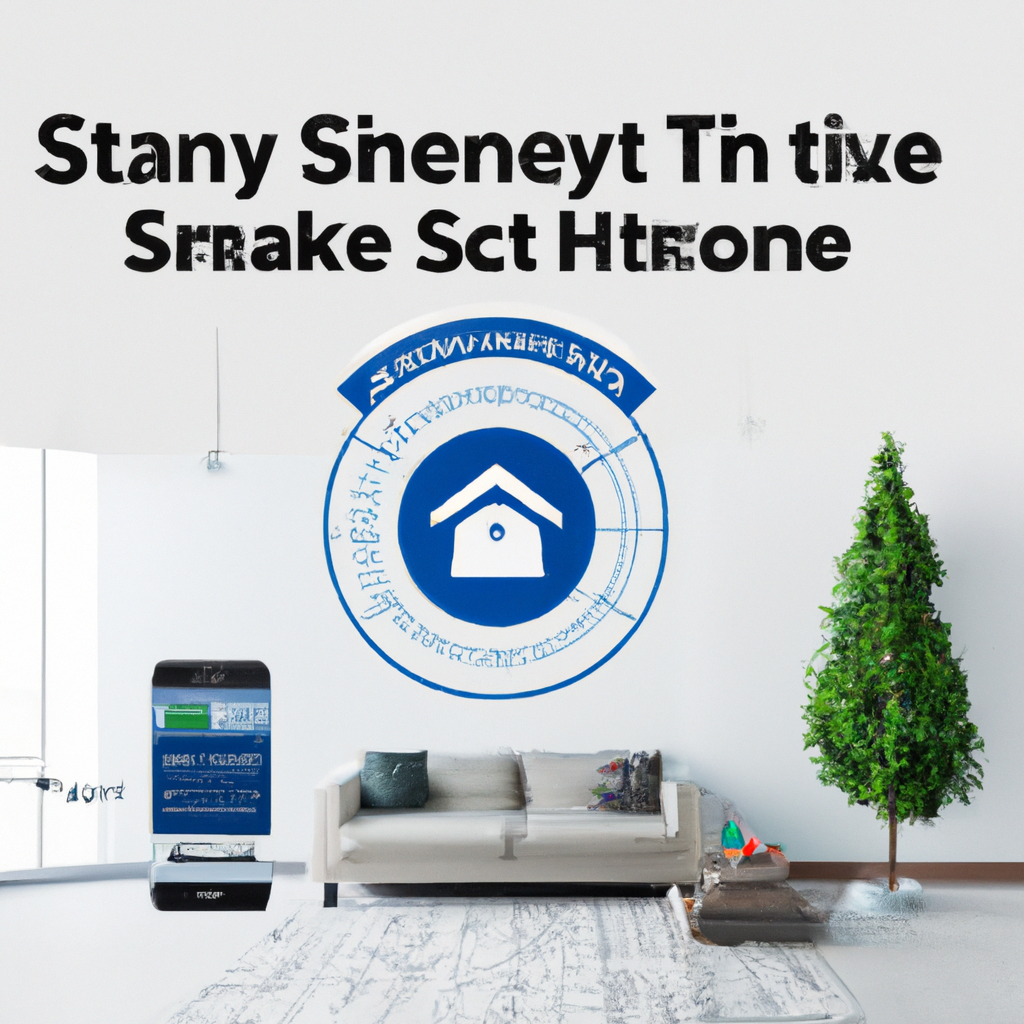Smart homes are becoming increasingly popular, offering convenience and security at our fingertips. But with this convenience comes the need to ensure the safety of our smart home networks. In this article, we will explore some practical tips and strategies that you can implement to secure your smart home network and protect your privacy. So, let’s dive in and discover how you can safeguard your smart home from any potential threats or breaches.
Securing Your Home Wi-Fi Network
Your home Wi-Fi network is the foundation of your smart home system, and it’s crucial to take steps to secure it from potential threats. Here are some essential measures you can take to safeguard your home Wi-Fi network:
Change the default network name (SSID)
When setting up your Wi-Fi router, it often comes with a default network name or Service Set Identifier (SSID). Hackers can easily identify the make and model of the router and exploit any vulnerabilities associated with it. To mitigate this risk, change the default network name to a unique one that doesn’t reveal any personal information.
Create a strong and unique network password (WPA2)
Using a strong and unique network password is vital to prevent unauthorized access to your Wi-Fi network. Make sure to choose a password that is not easily guessable, consisting of a combination of upper and lowercase letters, numbers, and symbols. Additionally, ensure you are using the most secure encryption protocol available, such as WPA2.
Enable network encryption
Enabling network encryption is an essential step in securing your home Wi-Fi network. Encryption scrambles the data transmitted between your devices and your router, making it unreadable to anyone without the encryption key. Ensure that you are using the highest level of encryption available, such as WPA2-PSK (AES).
Disable remote management
Remote management allows you to access and configure your router settings from outside your home network. However, this feature can also be exploited by hackers to gain unauthorized access to your router. To enhance security, disable remote management unless you specifically need it and ensure that remote access is password protected.
Implement MAC address filtering
MAC address filtering is an additional layer of security that can be enabled on your Wi-Fi router. It allows you to specify which devices can connect to your network based on their unique MAC addresses. By enabling MAC address filtering, you can prevent unauthorized devices from connecting to your network, even if they have the correct network password.
Regularly update router firmware
Manufacturers release firmware updates for routers to address security vulnerabilities and enhance performance. Make it a habit to regularly check for and install any available updates for your router firmware. These updates will help ensure that your router is protected against the latest security threats.
Disable WPS (Wi-Fi Protected Setup)
While Wi-Fi Protected Setup (WPS) provides an easy way to connect devices to your network, it has known vulnerabilities that can be exploited by attackers. It is recommended to disable WPS on your router to eliminate the risk of unauthorized access to your Wi-Fi network.
Hide your network name (SSID)
Hiding your network name or SSID can add an extra layer of security to your home Wi-Fi network. When your network name is hidden, it is not visible during the Wi-Fi network selection process. While this can make your Wi-Fi network less convenient to connect to, it can also deter potential attackers who may be scanning for visible networks.
Securing Your Smart Devices
Smart devices, such as smart TVs, thermostats, and voice assistants, have become an integral part of modern homes. However, these devices can also be susceptible to security breaches if not properly secured. Here are some tips to secure your smart devices:
Change default usernames and passwords
Smart devices often come with default usernames and passwords, which are easily accessible to attackers. Be sure to change these default credentials to unique and strong ones. Avoid using common or easily guessable passwords and consider using a password manager to handle your credentials securely.
Keep smart devices updated
Regularly updating your smart devices’ firmware is essential as manufacturers release updates to address security vulnerabilities and improve functionality. Check for updates periodically and apply them promptly to keep your devices secure.
Disable unnecessary features and services
Smart devices often come with a wide range of features and services, some of which may not be essential for your needs. Consider disabling any unnecessary features and services that could potentially expose your devices to security risks.
Use separate networks for smart devices
Creating separate networks for smart devices and other devices can help mitigate the risk of a compromised smart device accessing personal or sensitive data on other devices. Many routers support guest networks, which can be used to isolate smart devices from your primary network.
Regularly review and revoke device permissions
It’s important to regularly review the permissions granted to each of your smart devices. Some devices may have excessive permissions that are not necessary for their intended functionality. Revoke any unnecessary permissions to minimize the potential attack surface.
Set up two-factor authentication
Enabling two-factor authentication adds an extra layer of security to your smart devices. This means that in addition to entering a username and password, you will also need to provide a second form of verification, such as a fingerprint scan or a unique code sent to your phone, to access your devices.
Secure your smart home hub
If you have a smart home hub that connects and controls multiple smart devices, it is crucial to secure it properly. Routinely update its firmware, change default passwords, and ensure it is protected with strong encryption to safeguard your entire smart home network.
Consider using a VPN (Virtual Private Network)
Using a VPN can provide an added layer of security when accessing your smart home network remotely. A VPN encrypts your internet connection, making it difficult for potential attackers to intercept your data. It also helps protect your privacy by masking your IP address and location.

Securing Remote Access
Remote access to your smart home network allows you to control and monitor your devices even when you are away from home. However, it’s essential to secure remote access to prevent unauthorized access. Here are some measures to ensure secure remote access:
Enable strong authentication for remote access
Using strong authentication methods, such as complex passwords and two-factor authentication, is crucial when configuring remote access to your smart home network. Avoid using default credentials and choose long and unique passwords or passphrases to reduce the risk of brute force attacks.
Use a secure remote access protocol (such as SSH or VPN)
When configuring remote access, ensure you are using a secure protocol such as SSH (Secure Shell) or a VPN (Virtual Private Network). These protocols establish a secure and encrypted communication channel between your remote device and your home network, protecting your data from interception.
Disable remote access when not in use
If you don’t need remote access to your smart home network at all times, consider disabling it when not in use. By disabling remote access, you reduce the potential attack surface and minimize the risk of unauthorized access.
Regularly review and update remote access permissions
Reviewing and updating remote access permissions is essential to ensure that only authorized devices and individuals can access your smart home network remotely. Remove any outdated or unused permissions and regularly audit the list of devices with remote access privileges.
Monitor and analyze remote access logs
Enabling logging for remote access connections can help you monitor and analyze any suspicious activities. Monitoring the logs can help identify potential security breaches and take appropriate actions to mitigate any threats.
Implement network segmentation for remote access
Implement network segmentation to isolate your remote access devices from other devices on your network. This adds an extra layer of protection, as a compromised remote access device will have limited access to the rest of your smart home network.
Securing IoT Communication
Internet of Things (IoT) devices, such as smart bulbs and security cameras, communicate with each other and the cloud. Securing IoT communication is crucial to protect your smart home network from potential vulnerabilities. Here are some measures to enhance IoT communication security:
Secure your home network
A strong foundation starts with securing your entire home network. Follow the previously mentioned steps to secure your home Wi-Fi network, such as changing default credentials, enabling network encryption, and regularly updating router firmware.
Use strong and unique passwords for IoT devices
Each IoT device within your smart home network should have its own strong and unique password. Avoid reusing passwords and opt for a combination of numbers, letters, and symbols to prevent unauthorized access to your IoT devices.
Encrypt IoT communication
Ensure that your IoT devices and platforms utilize encryption protocols to secure their communication. Encryption adds a layer of privacy and prevents eavesdropping on sensitive data transmitted between your devices and the cloud.
Disable or limit unnecessary IoT features
IoT devices often come with various features and functionalities, some of which may not be crucial for your needs. Consider disabling or limiting any unnecessary features and services to reduce the potential attack surface.
Regularly update IoT device firmware
Manufacturers release firmware updates for IoT devices to address security vulnerabilities and improve performance. Regularly check for and install any available updates for your IoT devices to ensure they have the latest security patches.
Use a separate network for IoT devices
Creating a separate network dedicated solely to IoT devices can help isolate them from your primary home network. This can be done through network segregation or by using a separate Wi-Fi network with its own dedicated router.
Implement network monitoring and intrusion detection systems
Implementing network monitoring and intrusion detection systems can help detect and respond to any suspicious activities within your IoT devices. These systems can notify you of any potential security breaches and enable you to take appropriate actions to protect your smart home network.

Protecting Your Smart Home Network from External Threats
Securing your smart home network from external threats is crucial to safeguard your personal data and privacy. Here are some additional steps you can take to protect against external threats:
Install and update reliable antivirus and firewall software
Installing reliable antivirus and firewall software on your devices provides an extra layer of protection against malware and other cyber threats. Regularly update these security tools to ensure they stay effective against the latest threats.
Frequently scan your network for vulnerabilities
Perform frequent network vulnerability scans to identify any potential weaknesses that hackers could exploit. This allows you to take proactive measures to patch known vulnerabilities and reduce the risk of successful attacks.
Implement a network-wide intrusion prevention system
An intrusion prevention system (IPS) actively monitors your network and identifies and prevents potentially malicious activities. By implementing an IPS, you can block unauthorized access attempts and protect your smart home network from external threats.
Use a network security monitoring tool
A network security monitoring tool can help detect and respond to any suspicious network traffic or activities. It can provide real-time alerts and notifications, allowing you to take immediate action to protect your smart home network.
Regularly backup your smart home system
Regularly backing up your smart home system is crucial to protect your data in case of a security breach or system failure. Store backups in a secure location and periodically test the restoration process to ensure their integrity.
Employ strong physical security measures
While digital security is essential, it’s equally important to implement strong physical security measures to protect your smart home network. Secure your router and other network devices in a locked cabinet or room, and limit physical access to authorized individuals only.
Consider using a cybersecurity professional or service
If you are unsure about your ability to secure your smart home network, consider consulting a cybersecurity professional or service. They can perform a comprehensive assessment of your network and provide recommendations tailored to your specific needs.
Educating and Raising Awareness
Educating yourself and your household members about online security practices is crucial to maintaining a safe and secure smart home network. Here are some steps you can take to educate and raise awareness:
Stay informed about the latest threats and vulnerabilities
Keep yourself up to date with the latest news and developments in the field of cybersecurity. Stay informed about emerging threats and vulnerabilities to understand how they may impact your smart home network.
Educate and train household members
Educate and train all household members, including children, on safe online practices. Teach them about the importance of strong passwords, privacy settings, and the potential risks associated with sharing sensitive information online.
Teach children about safe online practices
Children are often more vulnerable to online threats. Teach them about the importance of not sharing personal information online, not clicking on suspicious links or downloading unknown files, and seeking adult guidance when faced with unfamiliar situations.
Identify and report any suspicious activities
Encourage all household members to be vigilant and report any suspicious activities or behaviors observed on their devices or within the smart home network. Prompt reporting can help prevent further damage and mitigate potential risks.
Engage in online security communities
Join online security communities and forums to connect with like-minded individuals. Engaging in these communities can provide valuable insights, tips, and best practices to enhance the security of your smart home network.

Configuring Secure Network Behavior
Configuring secure network behavior not only enhances the overall security of your smart home network but also helps ensure proper functioning of your devices. Here are some measures to consider:
Limit IoT devices’ internet access
Review the internet access requirements of your IoT devices and restrict their access to essential services only. Limiting their internet access reduces the potential attack surface and minimizes the risk of unauthorized access.
Disable unused IoT device functionalities
IoT devices often come with various functionalities, some of which may not be necessary for your specific needs. Disable or turn off any unused functionalities to reduce the potential attack surface and minimize security risks.
Implement network segmentation and VLANs (Virtual LANs)
Network segmentation divides your smart home network into smaller subnetworks, enhancing security by isolating different types of devices from one another. VLANs can help accomplish network segmentation, providing an extra layer of security.
Monitor and restrict IoT device communications
Regularly monitor the communication traffic of your IoT devices to identify any suspicious or unauthorized activities. Restrict outgoing and incoming connections to ensure IoT devices communicate only with trusted sources.
Apply access controls and firewall rules
Implement access controls and firewall rules on your router to restrict access to your smart home network. Configure the rules to allow only trusted devices and block any potential threats from entering your network.
Regularly change passwords and encryption keys
Regularly changing passwords and encryption keys is an effective measure to ensure the ongoing security of your smart home network. Rotate passwords and encryption keys periodically to prevent unauthorized access.
Disable UPnP (Universal Plug and Play)
UPnP is a networking protocol that allows devices to discover and automatically set up connections within a network. However, it also introduces potential security vulnerabilities. Disable UPnP on your router to minimize the risk of unauthorized device connections.
Addressing Privacy Concerns
Protecting your privacy is as important as securing your smart home network. Here are some steps you can take to address privacy concerns:
Review and adjust privacy settings
Review the privacy settings of your smart devices and platforms, ensuring that they align with your preferences. Adjust the settings to limit data collection and sharing to the extent that you are comfortable with.
Check and manage data collection practices
Examine the data collection practices of your smart devices and platforms, understanding the type of data collected, how it is stored, and who has access to it. Manage your data by deleting unnecessary information and regularly reviewing data-sharing permissions.
Use strong encryption for data storage and transmission
Strong encryption is essential to protect your data from unauthorized access. Ensure that your smart home devices and platforms utilize encryption for both data storage and transmission.
Regularly delete unnecessary data
Regularly delete any unnecessary data stored on your smart devices and platforms. This reduces the amount of personal information that could potentially be compromised in the event of a security breach.
Explore local-only or offline alternatives
Consider using local-only or offline alternatives for certain smart home functionalities. This can help minimize the transfer of sensitive data to external servers, enhancing your privacy and security.
Research and choose privacy-focused smart devices
When purchasing new smart devices, prioritize those manufactured by companies with a strong commitment to privacy. Research the privacy practices of different brands and choose devices that prioritize user privacy and data protection.
Consider disabling voice assistants’ listening capabilities
If privacy is a significant concern, you may consider disabling the listening capabilities of voice assistants when not in use. This can help mitigate the risk of unintentional recording and potential privacy breaches.

Monitoring and Responding to Threats
Continuously monitoring and promptly responding to security threats is essential to maintaining a secure smart home network. Here are some measures to consider:
Implement network traffic monitoring
Implement network traffic monitoring tools to keep track of the data flowing within your smart home network. These tools can help detect any abnormal or suspicious traffic patterns that may indicate a potential security threat.
Use intrusion detection and prevention systems
Intrusion detection and prevention systems (IDPS) monitor and analyze network traffic, identifying potential security breaches and preventing unauthorized access. Implementing an IDPS adds an extra layer of protection to your smart home network.
Set up security alerts and notifications
Configure your smart home network to send security alerts and notifications to your preferred devices or email addresses. These alerts can help you stay informed about potential security threats and take immediate action to mitigate them.
Monitor device behavior and anomalies
Regularly monitor the behavior of your smart devices to identify any unusual activity or anomalies. For instance, unexpected spikes in data usage or unfamiliar devices accessing your network could indicate a security breach.
Investigate and respond to security incidents
If you suspect a security incident or breach in your smart home network, investigate the matter promptly. Assess the extent of the breach, take immediate steps to mitigate the impact, and implement measures to prevent future incidents.
Regularly review and analyze logs for suspicious activities
Logs contain valuable information about network activity and can help identify any suspicious activities or patterns. Regularly review and analyze the logs of your smart home network devices, routers, and security systems to detect any potential security incidents.
Engaging Professional Help
For individuals who may lack the necessary expertise or resources to secure their smart home network effectively, professional assistance can be valuable. Here are some ways to engage professional help:
Consult with a cybersecurity professional
If you are uncertain about how to secure your smart home network, consider consulting with a cybersecurity professional. They can assess your network’s vulnerabilities and provide tailored recommendations to enhance its security.
Consider a professional penetration test
A professional penetration test, also known as ethical hacking, involves simulating real-world attacks to identify potential vulnerabilities in your smart home network. Engaging a professional penetration tester can help uncover hidden security flaws and strengthen your network’s defenses.
Engage a smart home security service
Smart home security services specialize in providing comprehensive security solutions for smart homes. They offer ongoing monitoring, intrusion detection, and response services to safeguard your smart home network round the clock.
Subscribe to real-time security threat feeds
Subscribe to real-time security threat feeds to stay updated about the latest security risks and vulnerabilities. These feeds provide valuable information on emerging threats, enabling you to take proactive measures to protect your smart home network.
Receive regular security audits and assessments
Engage a cybersecurity professional or service to conduct regular security audits and assessments of your smart home network. These audits help identify any weaknesses or gaps in your security measures and provide recommendations for improvement.
Find a trusted vendor or installer for smart devices
When purchasing new smart devices or considering professional installation, identify trusted vendors or installers who prioritize security and privacy. Research customer reviews and certifications to ensure the vendor or installer follows best practices.
By implementing these measures and adopting a proactive mindset towards securing your smart home network, you can enjoy the convenience and benefits of a smart home while effectively safeguarding your privacy and data. Stay informed, keep your devices up to date, and take appropriate action to address any potential security risks. A secure smart home is within reach, providing peace of mind and a safe environment for you and your family.











